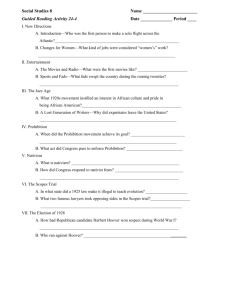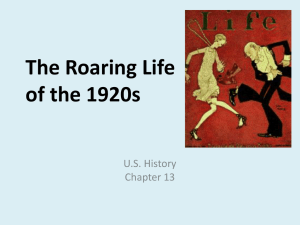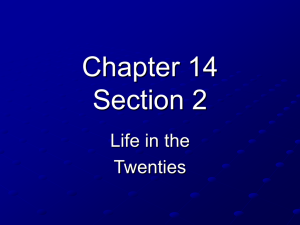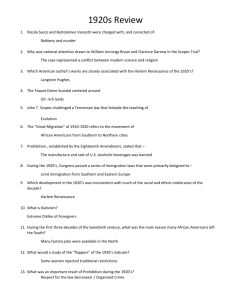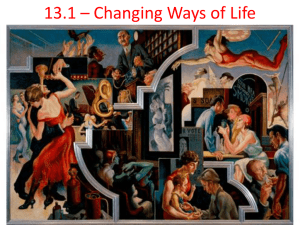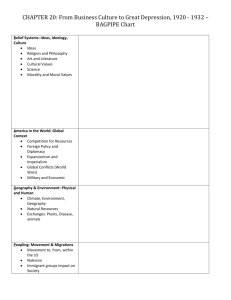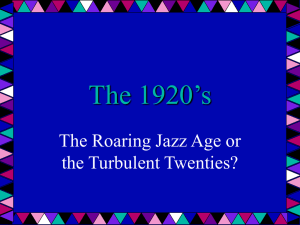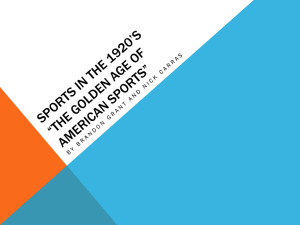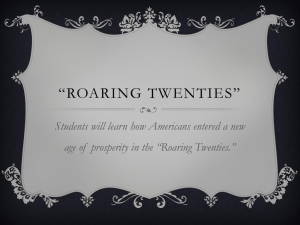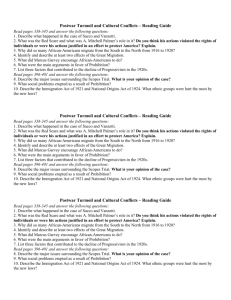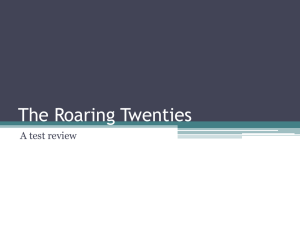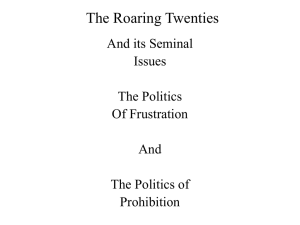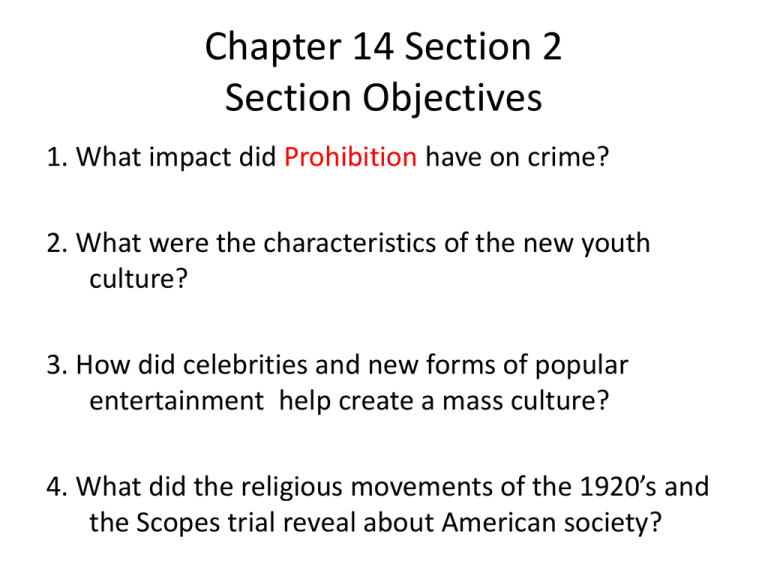
Chapter 14 Section 2
Section Objectives
1. What impact did Prohibition have on crime?
2. What were the characteristics of the new youth
culture?
3. How did celebrities and new forms of popular
entertainment help create a mass culture?
4. What did the religious movements of the 1920’s and
the Scopes trial reveal about American society?
Chapter 14 Section 2
Life in the Twenties
The 1920’s became the 1st time in American history that we
had a truly “mass culture” Radio, movies and the auto
increasingly linked our country coast to coast.
Prohibition
The 18th Amendment passed in 1919 prohibited the sale, manufacture
and transportation of alcoholic beverages. The Volstead Act was then
passed to enforce prohibition.
In some places prohibition was strictly enforced, but in cities it was
frequently ignored and many people went to speakeasies to drink.
Moonshine and smuggling from Canada, Mexico and the West Indies
were big business.
Prohibition and Crime
•
•
•
•
•
•
•
•
Bootlegging became very profitable
Criminal gangs controlled liquor sales
Al Capone ruled Chicago’s underworld
Violent wars were raged by gangs for turf
St. Valentines Day Massacre- 1929
The Kennedy’s gained their wealth
Widespread breakdown in law and order-corruption
Prohibition was repealed with the 21st Amendment
in 1933
*Prohibition did actually reduce alcoholism and
alcohol related deaths
Al Capone
St Valentine’s Day Massacre
Federal Prohibition Bureau
The FPB was set up to stop bootlegging.
Most law enforcement was corrupt BUT
Elliot Ness and his agents were relentless and
completely honest. They earned the nickname
the Untouchables because they couldn’t be
influenced by bribes. Elliot Ness was a media
and cultural hero
1920’s Youth Culture
Some members of the youth culture openly rejected
the values of the older generation
• The “New Woman”- Stylish, adventurous, independent and
career minded.
• Flappers were an ex.- They wore their hair short, no corsets,
short skirts and transparent silk hose and might even smoke
• Many of these women sought financial independence and
worked at nontraditional jobs, flying trucking, taxis
*Most women though were traditionalists and worked as
nurses, teachers and domestic servants
Stylish Flapper
College Life
Between 1900 and 1930 college enrollment tripled
• Most were from middle and upper classes
• They had a huge influence on popular culture
• Had a college look- baggy flannel slacks and sports
jackets
• Advertising, movies and magazines focused on their
styles and lifestyles
Leisure Fun and Fads
• Dance Marathons- could last days
• Beauty Contests
• Flag Pole SittingAlvin ‘Shipwreck” Kelley
• Marathon Bike Riding
Mass Entertainment
Many Americans had bigger paychecks and
more free time than in the past. To help fill
their time many turned to radio, movies and
professional sports for entertainment
Radio
Commercial radio began in the early 1920’s and by
1929 more than 800 stations reached over 10
million homes
•
•
•
•
•
Early 20’s radio broadcast a wide variety of programs
Advertising soon followed
Businesses would often sponsor shows
NBC began offering local stations packages of programs
A BIG effect was that Americans, coast to coast began
developing a shared culture- jokes, music, ads, serials
Movies- The Silver Screen
Originally movies were silent , the people loved them.
• Cecil B DeMille directed a new style of movie with epic plots
and complex characters-The Ten Commandments, Forbidden
Fruit
• Hollywood became the movie center
• Some of the early stars were : Lon Chaney, Tom Mix and
Charlie Chaplin
Charlie Chaplin as the “Tramp”
Clara Bow
Talkies
1927 saw the end of silent movies with the first “talkie”
called The Jazz Singer starring recording star Al Jolson
Overnight movies changed with musicals and newsreels bringing
in 80 million viewers each week
The rapidly changing standards of morality and sexuality
disturbed many Americans. Sex symbol Rudolph Valentino
created a lot of controversy with The Sheik.
In 1922 Will Hays became head of a movie group to limit
offensive matereial
The Sheik
Sports became a major entertainment in the 1920’s. Baseball was king
with millions of fans. Babe Ruth was #1, but others like Ty Cobb and
Lou Gehrig had huge support.
Red Grange was a major college football star that launched pro
football.
Bobby Jones in golf, Tilden in tennis and Tunney in boxing among many
others were popular stars
Baseball had an enormous scandal in 1919 with “Shoeless” Joe Jackson
and others being banned for life. That is why baseball has a
commissioner
Books and Magazines
New weekly and monthly publications entertained
millions
• Book- of –the- Month-Club: sold directly to
consumers
• Colliers and The Saturday Evening Post entertained
with cartoons, short stories and ads
• Reader’s Digest was a huge hit with its reprinted and
shortened stories
Celebrities and Heroes
The mass appeal of movies, radio and sports created hordes of
fans who shared in their heroes accomplishments and
copied their behavior
Heroes of the 1920’s
Babe Ruth- baseball superstar
Jim Thorpe- A star in every sport at his Indian school, went to the
1912 Olympics- 1st man to win both the pentathlon and the
decathlon.
Charles Lindbergh- 1st man to fly solo across the Atlantic Ocean
Amelia Earhart- 1st woman to fly across the Atlantic Ocean
Babe Ruth
Jim Thorpe
Charles Lindbergh
Amelia Earhart
Religion in the 1920’s
The declining moral standards of the 20’s alarmed many and
launched a new religious movement called Revivalism
Some revivalists like Aimee Semple McPherson combined a
strong message with the glamour of Hollywood. Her services
had sets, props and an orchestra. Her movement was closely
tied to Pentecostalism.
Pentecostalism:
• Multidenominational
• Experiencing the “Holy Spirit”- baptism, faith healing
• Emotional services, speaking in tongues
• Appealed to a diverse audience, particularly those with little
formal education
• Very successful- 11 million in the US and 100’s of millions
worldwide
Fundamentalism
Was a conservative response to the changing times. The goal
was to get back to the “Fundamentals” of Christianity
Fundamentalists felt the Bible should be interpreted literally and
felt other Christians who embraced science “Modernists” and
particularly evolution were sell outs and contributing to the
moral decline of the nation.
A major fundamentalist figure was Billy Sunday who through his
revivals and radio programs kept the audience spellbound
with his rousing attacks on card playing, drinking and dancing
The Scopes Trial
The Scopes Trial was a symbolic battle between the forces of
modernity- science and evolution- vs the fundamentalist’s
beliefs .
Short version: John Scopes a biology teacher accepted the
ACLU’s offer to test the Tennessee law against teaching
evolution. Clarence Darrow agreed to represent him. William
Jennings Bryan -a noted fundamentalist -agreed to prosecute
Scopes. Darrow used a 1st amendment defense and the case
was stacked against him. In the end Scopes was fined $100
but the withering cross examination of Bryan lowered some
people’s perception of fundamentalism
*It became a circus in Dayton Tennessee

